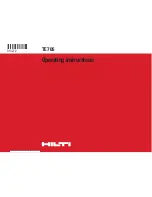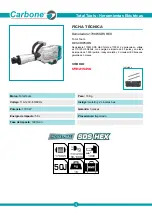
4
sprayed or spilled. Allow the hydraulic system to cool before conducting
maintenance.
5. Hydraulic components require regular inspection. Release all pressure from
the system before you inspect it. Replace damaged hydraulic parts with identical
manufacturer's components.
6. Do not attempt makeshift repairs to a hydraulic system. Such repairs can fail
suddenly and create a hazardous condition.
7. A damaged or disconnected hydraulic hose under pressure may whip around
and inflict personal injury or damage the work area. Secure the hose to a fixed or
permanent structure with clamps or cable ties.
8. Hydraulic fluid has a combustible flash point of 200°F (93°C). Do not expose
the fluid to an ignition source.
9. Change your clothing immediately if sprayed with hydraulic fluid. Store clothing
or rags contaminated with hydraulic fluid in an approved metal safety can with a
spring-closing lid and venting designed to contain a fire.
10. Only use hydraulic fluid in the pump. Do not substitute or mix brake fluid, or
any other fluid, with the hydraulic fluid. This can result in a pump failure and injure
the user or bystander. It may also damage the pump.
AIR TOOL PRECAUTIONS
1. Extended exposure to air tool noise may cause hearing loss. Ear protection
gear can reduce or eliminate the noise level.
2. Inspect the tool's air hose for cracks, fraying or other faults before each use.
Discontinue use if the air hose is damaged or hissing is heard from the air hose or
connectors, while operating the tool. Replace the defective component/air hose.
3. Do not allow people, mobile equipment or vehicles to pass over the
unprotected air hose. Position the air hose away from high traffic areas, in a
reinforced conduit or place planks on both sides of the air hose to create a
protective trench.
4. Prevent damage to the air hose by observing the following:
a. Keep the air hose behind the tool and out of the tool's work path.
b. Keep the air hose away from heat, oil, sharp edges or moving parts.
c. Do not wrap the air hose around the tool as sharp edges may pierce or crack
the air hose. Coil the air hose when storing.
5. A damaged or disconnected air hose under pressure may whip around and
inflict personal injury or damage the work area. Secure the compressor's air hose
to a fixed or permanent structure with clamps or cable ties.
6. Install an in-line shutoff valve or regulator to allow immediate control over the
air supply in an emergency, even if a hose is ruptured.
7. Check the manufacturer’s maximum pressure rating for air tools and
accessories. Compressor outlet pressure must be regulated so as to never
exceed the maximum pressure rating of the tool.
Summary of Contents for NEILSEN CT2594
Page 2: ......
Page 11: ......
Page 12: ...CANNON TOOLS LTD 20 Station road Rowley Regis West Midlands B65 0JU U K Made in China ...






























